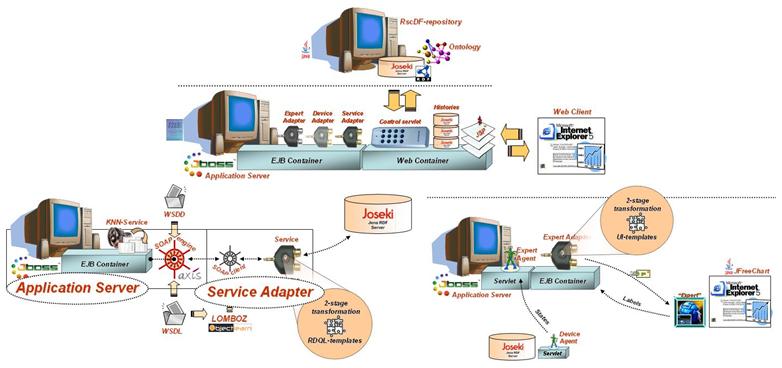|
Deliverable 1.3
Smart Resource Prototype Environment, v.1.0

For a practical testing of the developed approach of General Adaptation, the first version of the
target prototype environment has been implemented. Technical report contains the details of this implementation
and in addition corresponding UML diagrams and source code description are available (Omondo-generated). The
implementation of the environment is supplied on a project's CD and can be launched on a workstation, which meets
the specified requirements.
For the process of software engineering the latest and the most powerful freeware and open source
tools and technologies were used. The whole environment is based on Java 2 Platform, Enterprise Edition (J2EE)
and was developed using Eclipse Integrated Development Environment together with the Poseidon UML-based modeling
tool. Versioning control was carried out with help of the CVS tool. As it was mentioned, during the concerned year,
for testing the approach of General Adaptation Framework and the RSCDF format, three sample adapters were implemented
(project tasks T4, T5 and T6). Their logic was encapsulated in three Enterprise Java Beans (EJB) and executed on
the JBoss application server. Specification of the KF-330 blow molding machine was used for simulation of the device
data (7 device parameters). Device states were generated in a form of XML entities according to the corresponding XML
schemata (three different schema variations, plus a canonical one). State and Condition resource data encoded in RSCDF
after the transformation were stored in a remote Joseki RDF server. For creation of a local history cache, Jena classes
were used. Code that coordinated coherent work of the adapters and provided a control/monitoring over them, was executed
in the control Java Servlet. Visualization of the internal processes of the prototype environment was organized using a
set of Java Server Pages (JSP). Demonstrations were carried out using Internet Explorer web browser.
Web Service adapter incorporated learning algorithm (KNN-method) wrapped by a web service container using
Axis and Lomboz. The adapter using generated SOAP-client simulated software agent's requests for learning and diagnostics.
For RSCDF-XML transformations, the adapter uses approach of 2-stage transformation with RDQL-templates.
In the implementation of the human expert adapter, 2-stage transformation and User Interface Templates
were used for flexible building of a specific human interface. Involvement of the JFreeChart open Java library allowed
generating images for representation of the device states. Human Expert is requested for a diagnostics via e-mail.
|
|
|

